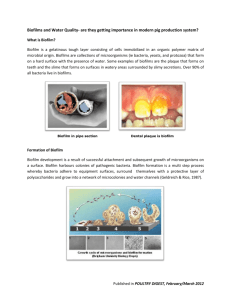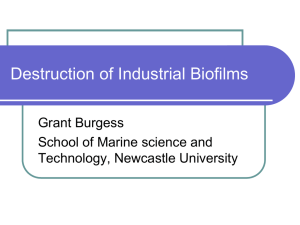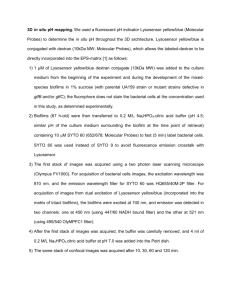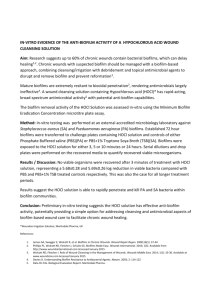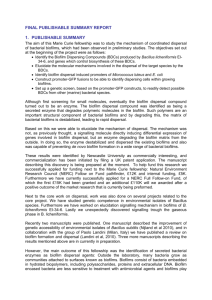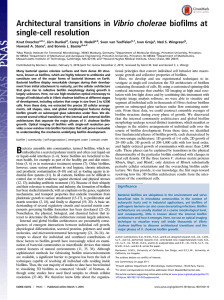Environmental Protection
advertisement
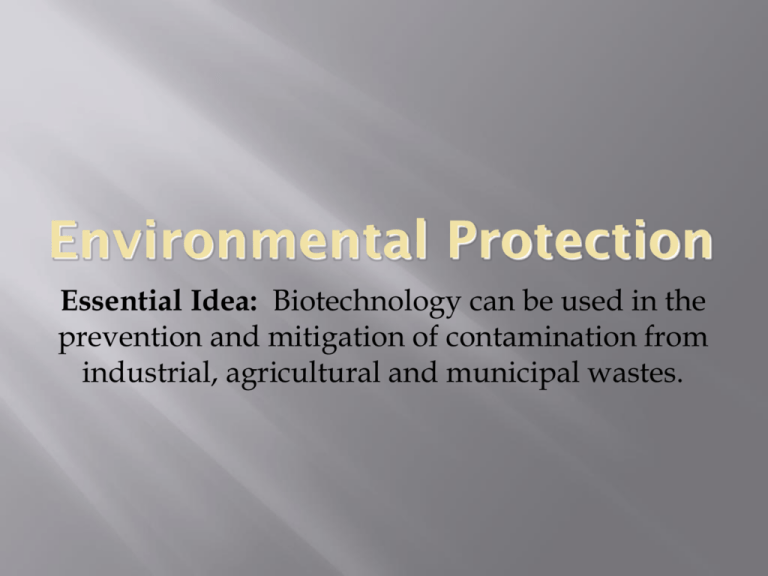
Environmental Protection Essential Idea: Biotechnology can be used in the prevention and mitigation of contamination from industrial, agricultural and municipal wastes. TOK Emergent properties are the outcome of the interaction of the elements of a system. In what context is a reductionist approach to science productive and in what context is a reductionist approach problematic? 2 Bioremediation In response to environmental pollution incidents, various methods of cleanup can be employed. Bioremediation Physical and Chemical procedures. Bioremediation Various physical and chemical means are often used to clean up a polluted area. Detergents Pressure washers 4 Bioremediation Physically scrubbing polluted areas with chemicals can also be used during clean up. http://www.maritimejournal.com/news101/pollution-control/put-bioremediation-into-pollution-toolkit 5 Use of Microorganisms Microorganisms are often used in bioremediation. http://biologybiozine.com/articles/unit-8-animals/the_loss_of_biodiversity-php 6 Bioremediation--How it Works Generally, some toxic substance is spilled into the environment. The waste kills most bacteria, but a few survive. The bacteria which survive can be cultured and used to break down the waste. Bacteria can also be engineered to break down the waste by inserting the correct gene/plasmid into the genome of the bacterium. Bioremediation The bacteria may change the waste into something less toxic, into smaller parts, or break it down completely. 9 Bioremediation-Examples: When oil is spilled, it poses many challenges for cleanup. Benzene and other types of polycyclic aromatic compounds are found the spill. The tendency for the oil to bind tightly to soil particles poses challenges for cleanup. It throws off the carbonnitrogen balance and hinders microbial growth. http://www.tanushchem.com/benzene.htm 10 Bioremediation-Examples: Certain genera of bacteria, such as Marinobacter and Pseudomonas are often used in the cleanup efforts. Marinobacter hydrocarbonoclasticus is a genus of proteobacteria found in sea water and readily degrades oceanic oil spills which often included aromatic compounds like benzene. Both images: https://microbewiki.kenyon.edu/index.php/File:Screen_shot_2012-1214_at_11.23.24_AM.png 11 Bioremediation-Examples: Some members of the Pseudomonas genus such as Pseudomonas aerugnosa and P. putida are used to metabolize hydrocarbons found in oil spills. http://www.agriculture.gov.bb/agri/index.php?option=com_content&view=article&id=704:amazing-and-interesting-bacteria-part2&catid=140:analytical-services&Itemid=132 12 Bioremediation-Examples: Methyl mercury is a common environmental pollutant from industry and can be broken down by many Pseudomonas species such as P. putida. The remaining mercury can be collected and removed from the environment. 13 Biofilms According to the IUPAC, a biofilm is an aggregate of microorganisms in which cells that are frequently embedded within a selfproduced matrix of extracellular polymeric substance (EPS) adhere to each other and/or to a surface. EPS is a sugary, molecular strand that helps to develop complex 3D structures. This makes the biofilm stronger and enables it to survive. 14 Biofilms Biofilms possess emergent properties: Initial attachment: Growth: Irreversible attachment: Maturation I: Maturation II: Dispersion: http://www.biofilm.montana.edu/node/2390 15 Initial Attachment The formation of a biofilm begins with the attachment of microorganisms to a surface. Initially these attachments are weak and reversible, due to Van der Waals interactions. http://www.biofilm.montana.edu/node/2390 16 Irreversible Attachment Later the attachment becomes more permanent as bacterial structures such as pili get involved in the attachment. http://www.biomedcentral.com/1471-2180/10/57/figure/F6?highres=y 17 Maturation I Cells of the biofilm communicate with other cells via quorum sensing. Quorum sensing is known to be involved in the formation of a biofilm in numerous bacterial species. http://www.biofilm.montana.edu/node/2410 18 Maturation II Once colonization has begun, the biofilm grows through cell division and recruitment of other bacteria. Most biofilms are diverse mixtures of many species of bacteria, fungi, algae, yeasts, protozoa, and many other microorganisms. https://microbewiki.kenyon.edu/index.php/File:Microbes_in_stream_biofilms.jpg 19 Maturation II Additionally, this stage is also characterized by the growth of polysaccharide matrices and inclusion of materials from the surrounding environment. These matrices act as an enclosure for the biofilm and increase the resiliency of the structure. http://medcraveonline.com/JMEN/images/JMEN-01-00014-g002.png 20 Dispersion Dispersion is the final stage of the formation of a biofilm. During this stage, the biofilm is well established and only changes in shape and size. This stage allows the colony to spread to new surfaces. http://www.biofilm.montana.edu/node/2390 Ubiquity of Biofilms Biofilms are ubiquitous, and are very important to the health and well being of the economy, and the people who live in it. Biofilms cost our economy billions of dollars each year. Energy loss Equipment damage Product contamination Medical infections https://www.biofilm.montana.edu/resources/images/biofilm-general-interest/biofilms-impact-human-health-and-industries.html Ubiquity of Biofilms Microorganisms growing in a biofilm are often highly resistant to antimicrobial agents. Biofilms have properties that differ quite a bit from the free-floating bacteria that comprise them. The dense extracellular matrix and outer layer of cells acts to protect the cells in the interior. Horizontal gene transfer between organisms facilitates a stable, more resilient biofilm. 23 Ubiquity of Biofilms Not all biofilms are more resistant to antimicrobials. Some biofilms show just as much susceptibility to antimicrobial agents as free-floating bacteria. 24 Biofilms in Bioremediation Biofilms offer a huge potential for helping to clean up environmental damage, hazardous waste clean up, and wastewater treatment. http://www.slideserve.com/kurt/bioremediation-and-biofilms 25 Biofilm and Wastewater Treatment Biofilms play an important role in wastewater treatment. Trickle filter beds are often built to facilitate the formation of a biofilm. The biofilm feeds off of the nutrients in the waste stream. https://powersoregonsewer.files.wordpress.com/2013/03/2013-wwtp-trickling-filter.jpg 26 Environmental Problems and Biofilms For all the good that biofilms do, there are many problems they can cause. They can clog or corrode pipes. They can contaminate surfaces of food production facilities. They can contaminate waterways through the transfer of ballast water from ships. http://trustwater.com/markets/hospitality/biofilm-removal/ 27


